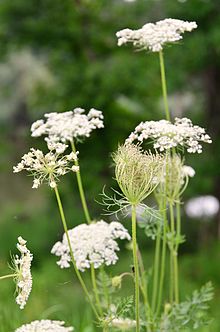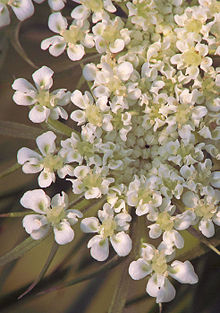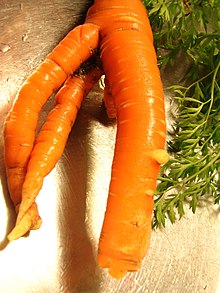Daucus carota
Daucus carota sativus, popularly called carrot or Davo, is the domesticated form of the wild carrot (Daucus carota i>), species of the umbelliferous family, also called apiaceae, and considered the most important and most consumed within this family. It is native to Europe and southwestern Asia. It is cultivated for its much larger, tastier root and less fibrous texture than the wild species.
Description
Biennial plant that forms a rosette of leaves in autumn and winter, while it develops the fine napiform root, which will store large amounts of sugar for the following year's flowering. The flower stem grows to about 10 cm with an umbel of white flowers at the apex. The edible root is usually orange and black or a combination of these, and even -more rarely- purple skin with a whitish interior.
Uses and nutrition
Carrots can be eaten in many different ways. They are usually cut into pieces, eaten raw, cooked, fried or steamed, and cooked in soups, stews, salads, cakes, as well as prepared foods for babies and pets.
It is an excellent food from a nutritional point of view thanks to its vitamin and mineral content. Water is the most abundant component, followed by carbohydrates, these nutrients being the ones that provide energy. Carrots have a higher carbohydrate content than other vegetables. Being a root, it absorbs nutrients and assimilates them in the form of sugars. The content of these sugars decreases after cooking and increases with maturation.
Its characteristic orange color is due to the presence of carotenoids, including beta-carotene or pro-vitamin A, an antioxidant compound that is transformed into vitamin A, which is good for sight once it enters our body. It is also a source of vitamin E and group B vitamins such as folates and vitamin B3 or niacin. As for minerals, the contribution of potassium stands out, and discrete amounts of phosphorus, magnesium, iodine and calcium.
Helps clean teeth and stimulates saliva secretion, which indirectly contributes to good digestion.
Vitamin A deficiency makes it difficult to see well at night, since the optic nerve is nourished by this vitamin and a protein called “opsin”, which is why carrots have always been linked to improving vision.
Increases the production of melanin, the pigment that gives skin its color and protects it from harmful solar radiation (UVA and UVB).
History
It is likely that the wild ancestors of the carrot came from Iran, which continues to be the center of diversity for the wild species D. face. Selective breeding over centuries of a natural subspecies of this, Daucus carota subsp. sativus, has given rise to the common vegetable.
In the past, carrots were grown for their aromatic leaves and seeds, not for their roots. Even today, some of its relatives are cultivated for these, such as parsley, fennel, dill, and cumin. In the I century the root is mentioned for the first time in classical sources. The modern carrot was possibly introduced to Europe between the 8th and 10th centuries[citation needed]; Ibn al-Awwam, in Andalusia, describes both the red and yellow varieties; Simeon Seth, a 11th century lowercase">11th century Judeo-Byzantine scholar and physician, also mentions both colors.
Orange carrots appeared in the Netherlands during the 16th century when Dutch farmers made a selection of colored carrots orange to honor the royal house of Orange. Such carotene-rich orange carrots were so successful that they are currently the most widespread globally.
Geographic distribution and habitat
Native to temperate Europe and southwestern Asia, the plant spread to North America and Australia.
It is common to find it on roadsides and in vacant fields. It does best in sun or partial shade.
Toxicity
Skin contact with Daucus carota foliage, especially wet foliage, can cause skin irritation in some people. It may also have a mild effect on horses.
The compound falcarinol occurs naturally in Daucus carota as protection against fungal diseases. Laboratory tests show that the compound is toxic to mice and the water flea Daphnia magna. Normal consumption of carrots has no toxic effects on humans.
Uses of the plant without domestication
Like cultivated carrots, the root of undomesticated D. carota is edible when young, but quickly becomes too woody to eat[citation needed] The flowers are sometimes battered and fried. The leaves and seeds are also edible.
D. carota bears a strong resemblance to poison hemlock, and the leaves of the wild carrot can cause phytophotodermatitis, so caution should also be exercised when handling the plant. The seeds and flowers have been used for centuries as a method of contraception and abortion. If used as a dye, the flowers give a creamy-white color.
D. carota, freshly cut, stains or changes color depending on the color of the water in which it is found. This effect is only visible on the "head" or flower of the plant. Carnations also have this effect. This phenomenon is a very popular science demonstration in elementary school.
Undomesticated Daucus carota as a beneficial plant
This beneficial plant can be used as a companion plant to crops. Like most members of the Umbelliferae family, it attracts wasps to its small flowers in its homeland; however, where it has been introduced, it attracts very few wasps. In northeastern Wisconsin, when introduced with blueberries, it was successful in attracting butterflies and wasps. This species has also been documented to increase tomato production when kept nearby, and can provide a microclimate of cooler, wetter air for lettuce., when intercropped with it. However, it has been listed as a noxious weed in the states of Iowa, Michigan, and Washington, and is considered a serious pest of pastures. Persists in the soil seed bank for two to five years.
Taste
Several different factors can cause a carrot root to have abnormal metabolites (especially 6-methoxymeline) that can cause a bitter taste in the roots. For example, carrots taste more bitter when grown in the presence of apples. Also, ethylene can easily stress, causing a bitter taste.
Cultivars
Cultivars of this vegetable are grouped into two broad classes: "oriental carrots" and "western carrots". Recently, a number of new cultivars have been produced for specific properties.
The largest carrot in the world was grown by John Evans in 1998 in Palmer, Alaska and weighed 8.6 kg.
The city of Holtville, California, promotes itself as the "Carrot Capital of the World," and hosts an annual festival dedicated exclusively to it.
Oriental Carrots
The eastern carrot originates from Central Asia, possibly present-day Afghanistan, during the X century or perhaps earlier. Specimens of this class that have survived to this day are usually purple (the color provided by anthocyanin pigments) or yellow and often have forked roots.
Western Carrots
The western carrot arose in the Netherlands during the 15th or 16th century[citation needed], becoming popular for its orange color (resulting from the abundance of carotenes) in those countries as an emblem of the House of Orange-Nassau and the fight for Dutch independence. Although orange carrots are common in the West, there are also other colors, such as white, yellow, red and purple, which have been produced recently.
The "Centro de Avance Vegetal" at Texas A&M University has developed a variety with purple skin and orange flesh, the BetaSweet (also known as the so-called brown carrot) with substances for the prevention of Cancer, which has begun limited distribution by J&D Produce of Edinburg TX, is also high in beta-carotene, which gives it its peculiar brown color.
Diseases
Among many other bacterial and/or fungal diseases, the black rot of carrots, caused by the fungus Stemphylium radicinum, causes the leaves to darken or die and destroys the root.
At the production level, it is mainly affected by fungal diseases that attack the foliage, among which the genera Phytophtora and Cercospora stand out. It is a plant very susceptible to attack by phytoparasitic nematodes, especially the species Heterodera carotae, which causes serious quality losses due to root bifurcation (if the attack occurs at an early age) and the appearance of nodules (if the attack is late).
Production trends
China was the largest producer of carrots and turnips in 2005 according to the FAO, accounting for at least a third of global production, followed by Russia and the United States.
In 2005, a British survey of 2,000 people revealed that the carrot is the third favorite food vegetable in that country.
Taxonomy
Daucus carota was described by Charles Linnaeus and published in Species Plantarum 1: 242. 1753.
In 2016, an international team sequenced the complete genome of Daucus carota.
- Etymology
The name carrot comes from the Andalusian Arabic اِسفاناريجا (safunnárya), and the latter from the ancient Greek σταφυλίνη ἀγρία (staphylínē agría).
Some varieties
- Daucus carota azoricus Franco
- Daucus carota boissieri (Schweinf.) Hosni
- Daucus carota commutatus (Paol.) Thell.
- Daucus carota drepanensis (Arcang) Heywood
- Daucus carota gadecaei (Rouy & E.G.Camus) Heywood
- Daucus carota gummifer (Syme) Hook.f.
- Daucus carota halophilus (Brot.)
- Daucus carota hispanicus Thell.
- Daucus carota majoricus A. Pushes
- Daucus carota maritimus (Lam.) Batt.
- Daucus carota maximus (Desf.) Ball
- Daucus carota rupestris (Guss) Heywood
- Daucus carota sativa (Hoffm.) Arcang.
Synonymy
- Carota sylvestris (Mill.) Rupr.
- Caucalis carnosa Roth
- Caucalis carota (L.) Crantz
- Caucalis daucus Crantz
- Caucalis glabra Forssk.
- Daucus allionii Link
- Daucus australis Kotov
- Daucus blanchei Reut.
- Daucus brevicaulis Raf.
- Daucus communis Rouy & E.G.Camus
- Daucus carota dentatus (Bertol.) Fiori
- Daucus esculentus Salisb.
- Daucus exiguus Steud.
- Daucus gingidium Georgi
- Daucus glaber Opiz ex Celak.
- Daucus heterophylus Raf.
- Daucus hispidus (Arcang.) Gilib.
- Daucus kotovii M. Hiroe
- Daucus levis Raf.
- Daucus marcidus Timb-Lagr.
- Daucus maritimus With.
- Daucus montanus Schmidt ex Nyman
- Daucus neglectus Lowe
- Daucus nudicaulis Raf.
- Daucus officinalis Gueldenst. ex Ledeb.
- Daucus polygamus Jacq. ex Nyman
- Daucus scariosus Raf.
- Daucus sciadophylus Raf.
- Daucus strigosus Raf.
- Daucus sylvestris Mill.
- Daucus vulgaris Garsault
- Daucus vulgaris Neck.
Common names
- Castellano: acenoria, azanoria, scarves, cart, carlota, carruchera, cenoria, grass, pastinaca, prados beach, breakssacos, satanoria, yerba meona, yerba mosquera, zanahoria, zanahoria wild.
Additional bibliography
- Blanchan, Neltje (2005). Wild Flowers Worth Knowing. Project Gutenberg Literary Archive Foundation. https://www.gutenberg.org/ebooks/8866 (in English)
- Bradeen, James M.; Simon, Philipp W. (2007). Vegetables. Genome Mapping and Molecular Breeding in Plants (in English). New York: Springer Verlag. pp. 162-184. ISBN 978-3-540-34535-0.
- Clapham, A. R.; Tutin, T. G.; Warburg, E. F. (1962). Flora of the British Isles. Cambridge University Press. (in English)
- Mabey, Richard (1997). Flora Britannica. London: Chatto and Windus.(in English)
- Rose, Francis (2006). The Wild Flower Key (edition revised and expanded by Clare O'Reilly). London: Frederick Warne. ISBN 978-0-7232-5175-0. (in English)
- Rubatsky, V.E.; Quiros, C.F.; Siman, P.W. (1999). Carrots and Related Vegetable Umbelliferae. CABI Publishing. ISBN 978-0-85199-129-0. (in English)
Contenido relacionado
Cortegada Island
Viola × wittrockiana
Regional park







